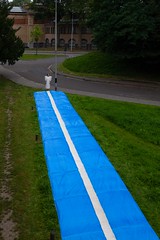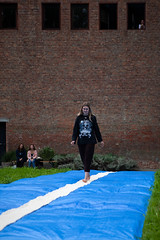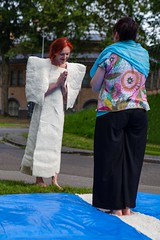joint performance, Marie Julia Bollansée and the audience
at S.M.A.K. Gent, on Sunday 19/9/2021 from 1PM until 5PM
https://smak.be/nl/agenda/river-marie-julia
Hadewych Cocquyt, photographs
Cynthia Vertessen en Pablo Bollansée, video-camera
Mit Hendrickx, knitwork
Marie Julia Bollansée, concept, performance, felt garb, videoreport
Ann Hoste, curator
S.M.A.K. staff ,making it happen
Alicia, Dirk, Linde, Nomi, Suzanna, assistance
Abbey Westmalle, Extra Trappist
As an extension of her exhibition GEOLOGY, Marie Julia Bollansée presents a new performance: RIVER. The artist sees rivers as the veins of the earth that carry vital water from its source to the seas. If these arteries are blocked or severed, human lives are in danger. On the lawn next to S.M.A.K., Bollansée creates a new landscape with the “tarpaulin blue” sails typical of her work and a long strip of knitted fabric. She invites visitors to enter the landscape and accompanies them as they cross the river. Ann Hoste, curator
“I spread a white, long knitted fabric on a lawn next to S.M.A.K. It was devotedly knitted by my wise mother, using my own handspun yarn. To me, spinning is a form of meditation in the germ that gives rise to works, such as this performance.
The strip resembles a white, narrow river; the landscape it bisects turns ‘tarpaulin blue’.
We all come into contact with ‘flows’ in our lives, both literally and figuratively. Sometimes we have to cross rivers, at other times we can go with the flow. Rivers, the veins of the earth, carry vital water from its source to the seas. If these arteries are blocked or severed, our lives are in danger.
In the performance RIVER, I invite the audience to remove their shoes and socks and step barefoot across the white, narrow river. I ask them to concentrate, not to talk, not to look back and to proceed individually and slowly. A free glass of Trappist beer, a gift from the abbot of Westmalle Abbey, awaits them at the finish.”
In form, RIVER resembles the work of Giotto, an artist I admire because he was the first Renaissance painter to fall in love with the colour blue. He painted the entire ceiling of the Scrovegni Chapel in Padua with the magical blue pigment created from the lapis lazuli found in Afghanistan, allowing the golden stars to shine within. Under the lapis lazuli sky and in long strips, he sketched biblical scenes from the life of Jesus and his ancestors (on his mother’s side).
RIVER finds its origin in Benares (India) and Kathmandu (Nepal). Benares, or Varanasi, is an ancient city situated on the banks of the Ganges. In India, Hindus aspire to make a pilgrimage to Varanasi at least once in their lifetime and, if possible, to even die there. Their bodies can thus be cremated on the pyres that line the water’s edge, the ashes of which are scattered in the Ganges. Only then are their souls liberated and they can enter Nirvana. In Kathmandu I witnessed the same funeral rites taking place on the banks of the Bagmati River. Hindus and Buddhists both have great faith in their rivers. The waters of their sacred rivers have the power to purify them spiritually. Being there, I saw and smelled how terribly polluted the Ganges and the Bagmati River are nowadays.
I created a participatory performance especially for Benares: I spread my blue tarpaulin on the banks of the Ganges and asked people to walk barefoot across it, following the direction of the current.
extended photo album on FLICKR
joint performance Marie Julia Bollansée en het publiek
in S.M.A.K. Gent, op zondag 19/9/2021 van 13.00u tot 17.00u
https://smak.be/nl/agenda/river-marie-julia
Hadewych Cocquyt, foto’s
Cynthia Vertessen en Pablo Bollansée, camera
Mit Hendrickx, breiwerk
Marie Julia Bollansée, concept, performance, vilten kleed, videoreport
Ann Hoste, curator
S.M.A.K. staff making it happen
Alicia, Dirk, Linde, Nomi, Suzanna, assistentie
Abdij Westmalle, Extra Trappist
Marie Julia Bollansée presenteert haar nieuwe performance: RIVER. De kunstenaar aanziet rivieren als de aders van de aarde die het vitale water van de bron naar de zeeën voeren. Als deze aders vastlopen of breken, zijn mensenlevens in gevaar. Op het grasveld naast S.M.A.K. creëert Bollansée een nieuw landschap met de voor haar werk typerende “tarpaulin blue”-zeilen en een lange strook breiwerk. Ann Hoste, curator
Ik strek een wit, lang breiwerk uit over een grasveld naast S.M.A.K.. Mijn wijze moeder breidde het met toewijding uit het garen dat ik met de hand heb gesponnen. Spinnen is voor mij een vorm van meditatie in de kiem waarvan werken ontstaan, zoals deze performance.
Het breiwerk is een witte, smalle rivier; het landschap dat het doormidden snijdt kleurt ‘tarpaulin blauw’.
In ons leven komen we allemaal in aanraking met ‘stromen’, zowel letterlijk als figuurlijk. Soms moeten we rivieren oversteken, soms kunnen we ons laten meedrijven met de stroming.
Rivieren, de aders van de aarde, voeren het vitale water van de bron naar de zeeën. Wanneer de aders vastlopen of breken, zijn onze levens in gevaar.
In de performance RIVER nodig ik het publiek uit om hun schoenen en sokken uit te trekken en blootsvoets over de witte, smalle rivier te stappen. Ik vraag hen om zich te concentreren, niet te praten, niet achterom te kijken en individueel en langzaam verder te gaan. Bij het eindpunt wacht een gratis glas trappist, een geschenk van de abt van de abdij van Westmalle.
Vormelijk refereert RIVER naar Giotto, een kunstenaar die ik bewonder omdat hij als eerste Renaissance-schilder verliefd werd op de kleur blauw. Hij schilderde het volledige plafond van de Scrovegni Kapel in Padua in het magische blauwe pigment dat afkomstig is van de lapis lazuli uit Afghanistan en liet er gouden sterren in schitteren. Onder de lapis lazuli hemel en in lange stroken, schilderde hij bijbelse taferelen uit het leven van Jezus en zijn voorouders (van moeders zijde).
RIVER vindt haar oorsprong in Benares (Indië) en Kathmandu (Nepal). Benares, of Varanasi, is een oude stad die aan de oevers van de Ganges ligt. In Indië willen Hindus op zijn minst één keer in hun leven een bedevaart ondernemen naar Varanasi en, als het kan, er zelfs sterven zodat hun lichaam gecremeerd wordt op één van de brandstapels aan de rand van de rivier en hun as verstrooid in de Ganges. Dan pas zal hun ziel bevrijd worden en kunnen zij het Nirvana binnentreden. In Kathmandu zag ik hoe dezelfde begrafenisrituelen zich afspeelden aan de oevers van de Bagmati-rivier. Hindus en Boeddhisten hebben groot vertrouwen in hun rivieren. Het water van hun heilige rivieren heeft de kracht om hen spiritueel te zuiveren. Toen ik daar was zag en rook ik hoe verschrikkelijk vervuild de Ganges en de Bagmati-rivier vandaag zijn.
Speciaal voor Benares creëerde ik een participatieve performance : ik spreidde mijn blauwe zeildoek uit bij de oever van de Ganges en vroeg aan blootvoetse voetgangers om erover te wandelen in dezelfde richting als de stroom.
volledig foto-album op FLICKR





























